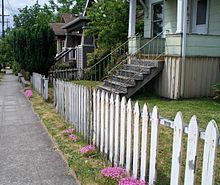
Polyvinyl chloride (alternatively: poly(vinyl chloride), colloquial: polyvinyl, or simply vinyl; abbreviated: PVC) is the world's third-most widely produced synthetic polymer of plastic (after polyethylene and polypropylene). About 40 million tons of PVC are produced each year.

A fence is a structure that encloses an area, typically outdoors, and is usually constructed from posts that are connected by boards, wire, rails or netting. A fence differs from a wall in not having a solid foundation along its whole length.

Canvas is an extremely durable plain-woven fabric used for making sails, tents, marquees, backpacks, shelters, as a support for oil painting and for other items for which sturdiness is required, as well as in such fashion objects as handbags, electronic device cases, and shoes. It is popularly used by artists as a painting surface, typically stretched across a wooden frame.
Flooring is the general term for a permanent covering of a floor, or for the work of installing such a floor covering. Floor covering is a term to generically describe any finish material applied over a floor structure to provide a walking surface. Both terms are used interchangeably but floor covering refers more to loose-laid materials.

In agriculture, fences are used to keep animals in or out of an area. They can be made from a wide variety of materials, depending on terrain, location and animals to be confined. Most agricultural fencing averages about 4 feet (1.2 m) high, and in some places, the height and construction of fences designed to hold livestock is mandated by law.
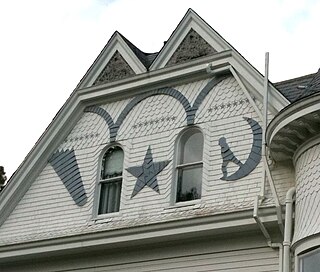
Siding or wall cladding is the protective material attached to the exterior side of a wall of a house or other building. Along with the roof, it forms the first line of defense against the elements, most importantly sun, rain/snow, heat and cold, thus creating a stable, more comfortable environment on the interior side. The siding material and style also can enhance or detract from the building's beauty. There is a wide and expanding variety of materials to side with, both natural and artificial, each with its own benefits and drawbacks. Masonry walls as such do not require siding, but any wall can be sided. Walls that are internally framed, whether with wood, or steel I-beams, however, must always be sided.

Vinyl composition tile (VCT) is a finished flooring material used primarily in commercial and institutional applications. Modern vinyl floor tiles and sheet flooring and versions of those products sold since the early 1980s are composed of colored polyvinyl chloride (PVC) chips formed into solid sheets of varying thicknesses by heat and pressure. Floor tiles are cut into modular shapes such 12-by-12-inch squares or 12-by-24-inch rectangles. In installation the floor tiles or sheet flooring are applied to a smooth, leveled sub-floor using a specially formulated vinyl adhesive or tile mastic that remains pliable. In commercial applications some tiles are typically waxed and buffed using special materials and equipment.
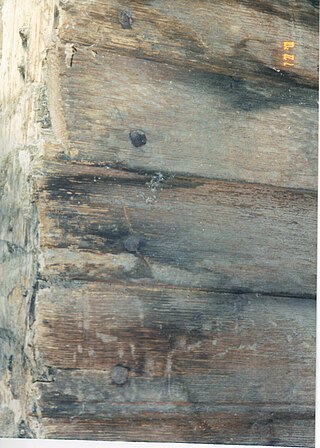
Clapboard, also called bevel siding, lap siding, and weatherboard, with regional variation in the definition of those terms, is wooden siding of a building in the form of horizontal boards, often overlapping.

Guard rails, guardrails, railings or protective guarding, in general, are a boundary feature and may be a means to prevent or deter access to dangerous or off-limits areas while allowing light and visibility in a greater way than a fence. Common shapes are flat, rounded edge, and tubular in horizontal railings, whereas tetraform spear-headed or ball-finialled are most common in vertical railings around homes. Park and garden railings commonly in metalworking feature swirls, leaves, plate metal areas and/or motifs particularly on and beside gates.
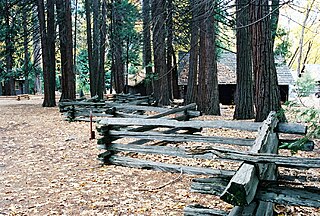
A split-rail fence, log fence, or buck-and-rail fence is a type of fence constructed in the United States and Canada, and is made out of timber logs, usually split lengthwise into rails and typically used for agricultural or decorative fencing. Such fences require much more timber than other types of fences, and so are generally only common in areas where wood is abundant.
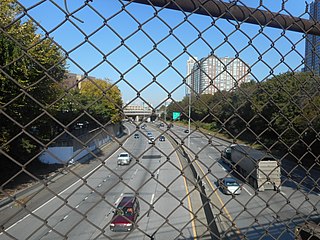
A chain-link fence is a type of woven fence usually made from galvanized or linear low-density polyethylene-coated steel wire. The wires run vertically and are bent into a zigzag pattern so that each "zig" hooks with the wire immediately on one side and each "zag" with the wire immediately on the other. This forms the characteristic diamond pattern seen in this type of fence.

Blue Vinyl is a 2002 documentary film directed by Daniel B. Gold and Judith Helfand. With a lighthearted tone, the film follows one woman's quest for an environmentally sound cladding for her parents' house in Merrick, Long Island, New York. It also investigates the many negative health effects of polyvinyl chloride in its production, use and disposal, focusing on the communities of Lake Charles and Mossville, Louisiana, and Venice, Italy. Filming for Blue Vinyl began in 1994. It was aired on HBO as part of the series America Undercover.
Vinyl banners are a form of banners made of vinyl. The most commonly used material is PVC. Most banners are now digitally printed on large format inkjet printers which are capable of printing a full color outdoor billboard on a single piece of material. They are used for outdoor advertising.

A swimming pool fence is a type of fence placed around swimming pools, to create a passive barrier to restrict the access of small children to the swimming pool. Swimming pool fences must have a self-closing and self-latching gate/s to be compliant to most countries' laws and codes.

A digging bar is a long, straight metal bar used for various purposes, including as a post hole digger, to break up or loosen hard or compacted materials such as soil, rock, concrete and ice or as a lever to move objects. Known by other names depending on locale, structural features and intended purpose such as a hop bar or crowbar in Britain, Australia and New Zealand, and slate bar, shale bar, spud bar, pinch point bar or San Angelo bar in North America, or just a bar. In Hawaii, a similar, traditional wooden device known as an ‘o‘o stick is used as a digging bar in groundbreaking ceremonies. Not to be confused with a curved crowbar, which is designed to provide leverage rather than to dig.

A synthetic fence, plastic fence or (when made of vinyl) vinyl or PVC fence is a fence made using synthetic plastics, such as vinyl (PVC), polypropylene, nylon, polythene (polyethylene) ASA, or from various recycled plastics. Composites of two or more plastics can also be used to increase strength and UV stability of a fence. Synthetic fencing was first introduced to the agricultural industry in the 1980s as low-cost, durable horse fencing. Now, synthetic fencing is used for agricultural fencing, horse race track running rail, and residential use. Synthetic fencing is generally available preformed, in a wide variety of styles. It tends to be easy to clean, resists weathering and has low maintenance requirements. However, it also can be more expensive than comparable materials, and cheaper products can be less sturdy than more traditional fence materials. Some types may become brittle, faded or degrade in quality after long exposure to extreme hot or cold conditions. Recently, titanium dioxide (TiO2) and other UV stabilisers have proven to be a beneficial additives in the manufacturing process of vinyl. This has greatly improved the durability of vinyl by providing essential UV protection from the sun's harmful rays, preventing premature ageing and cracking of the product, making it more durable than other materials such as wood.

Roofline is used to describe the fascia, soffits, bargeboards and antefixes that forms the frontage immediately below the roof and the eaves of many homes and buildings. These are traditionally made from wood, but can be made of a variety of different materials, including plastic, such as polyvinyl chloride.

Cavaletti are small jumps, originally made of wood, used for basic horse training. Most consist of rails that are about 4 inches (10 cm) wide, and 10 feet (3.0 m) long. The rails are inserted into fixed standards, usually made in an "X" shape, that commonly are designed to be placed at one of three preset heights ranging from a few inches off the ground to a maximum of about 18 to 24 inches. However, in informal terminology, even ground rails without standards are sometimes called "cavaletti." Modern designs can be made from various types of molded plastic and PVC pipe as well as wood. They can be used both for ground training with the handler working a horse on a longe line or at liberty, or while a rider is mounted on the horse. Cavaletti are used by practitioners of both English riding and western riding. Similar obstacles of lighter weight materials are used with dogs in dog agility and canine physical therapy.
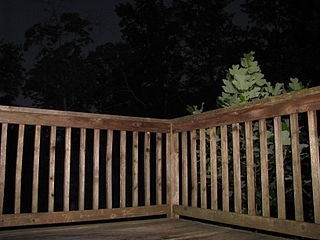
Deck railing is a guard rail to prevent people falling from decks, stairs and balconies of buildings. Over time, many different styles of deck railing have been developed.

PVC clothing is shiny clothing made from the plastic polyvinyl chloride (PVC). PVC plastic is often called "vinyl" and this type of clothing is commonly known as "vinyl clothing". PVC is sometimes confused with the similarly shiny patent leather.
